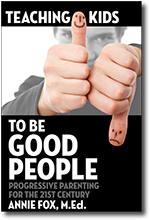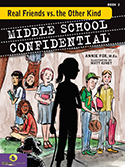Guiding Teens through
an Emotional Time
by Annie Fox, M.Ed
If your child is upset and willing to talk about what’s going on, these steps can help him/her calm down and figure out the next best move. If your child’s upset but not yet ready to talk about it, respect that, and check back with him/her later. If your son/daughter is unwilling to talk to you for whatever reason and your gut tells you that he/she needs to talk to someone… get the help of another adult that you and your child know and trust.
- Encourage your child to ACKNOWLEDGE that he’s stressing – It’s a positive first step for a kid to say “I’m STRESSED!” That’s so much better than pretending they’re not upset when clearly they are.
- They need to STOP – Tell them that. Even if they’re in the middle of an argument or the middle of a word… tell them to just STOP.
- Tell them (calmly but firmly) to CALM DOWN – If they ask why, the answer is: “Because it’s the best thing you can do right now for yourself and the people around you.” Breathe. Count to 50. Take a break or a walk. Whatever it takes to calm down is good as long as it’s legal, healthy, respectful, and not against your core values. Explain that if they don’t calm down, stress will control them and they won’t get to Step #4 where the solution to their problem really begins.
- THINK about your goal – Ask your son or daughter: “What are you trying to make happen in this situation?” In other words: “What’s your goal?”
- THINK SOME MORE: Ask: “Do you have any control over making that happen?” If what they want involves a change in someone else’s feelings or behavior, then that goal is out of their hands. They have to let it go. Instead, they need to create a goal that has to do with THEIR OWN choices. That’s all they can ever control.
- Ask: “What are your OPTIONS for reaching your goal?” – Help them make a list of all their options and encourage them to predict what might happen if they chose any of them. Even very young children can learn to do this. Don’t evaluate the options for your child. This is an exercise in critical thinking… let them think things through and come to their own conclusions. Your job is to facilitate the process.
- Ask them to CHOOSE the option that best HELPS the situation – Advise them that options which hurt other people, anger them, or put you at risk, will only make things worse. They’ll also create more stress and bring your child back to Step 1.
- TAKE ACTION – Encourage your child to act on the option that makes the best sense.
- CONGRATULATE your child for calming down and thinking things through.
















